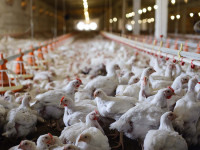Money
Demand for medicines to reach 71.65 tonnes annually by 2024-25, report says
The country imports pharmaceutical products worth Rs28.65 billion annually, mainly from India, Industry Department reports.
Krishana Prasain
The demand for pharmaceutical products in Nepal will increase to 71.65 tonnes in the next five years, rising at an annual rate of 7 percent, according to the latest report.
According to the Detail Study of Pharmaceutical and Medicine Manufacturing Industries in Nepal, prepared by the Department of Industry, the annual demand for pharmaceutical products currently stands at 53.66 tonnes.
The study has been conducted to analyse the current status of human allopathic medicine (pharmaceuticals) manufacturing factories with respect to demand, supply, energy consumption and challenges for sustainability.
The report estimates the total pharmaceutical market of Nepal to be worth Rs53 billion. Nepal imports pharmaceutical products worth Rs28.65 billion mainly from India and medicines worth Rs 24 billion are produced by domestic factories.
At present, there are 62 pharmaceutical factories manufacturing human related medicines, 8 pharmaceutical factories manufacturing medicines for animals and 73 ayurvedic medicine manufacturing factories. More than 30 factories are under process of getting licenses for marketing purposes.
There are 390 foreign pharmaceutical manufacturers supplying medicines through importers in Nepal.
Nepal imports 70 percent of raw materials from India and the remaining 30 percent from China. India imports around 80 percent of the intermediate products from China to manufacture raw materials.
Deepak Prasad Dahal, immediate past president of Association of Pharmaceutical Producers of Nepal (APPON), said as the government policy is more import-oriented, the growth of the domestic drug industry has remained stagnant despite huge demand for medicines.
“In terms of quality, we can compete with any other products in the world,” said Dahal, who is also the CEO of MDH Pharmaceuticals.
“But due to the government policy, domestic pharmaceutical products cannot even compete in the local market as imported medicines are comparatively cheaper.”
Biplab Adhikari, general secretary of the association, said that the Covid-19 pandemic has dealt a severe blow to the pharmaceutical industry and if the government does not protect this sector, many factories will shut in the near future.
“The government should stop importing pharmaceutical products that are produced domestically,” said Adhikari, who is also managing director of Innovative Pharma Lab.
Nepal is dependent heavily on India and India is dependent on China for the raw materials and intermediate products have reduced sharply in China, as a result, the cost has gone up two to three fold, according to the report.
Currently, most of the domestic factories are either shut down or running at 20 percent capacity. The industry is facing problems importing raw materials from India due to the pandemic, the report said.
India is the second largest country in terms of pharmaceutical products and exports at comparatively cheaper rates due to which domestic products cannot compete with Indian ones, industry insiders said.
Though the government introduced the Safeguard, Anti-Dumping and Countervailing Act, 2019, it has not come into implementation yet, Dahal added.
Imported medicine from India commands the lion’s share of the Nepali market at 52 percent while domestically produced medicine holds 46 percent. Imported medicine from other countries make up the remaining 2 percent of the market.
The report said that mostly vaccines, biotechnological products and modern technology related medicines used for Anti-cancer and critical care among others are imported.
“If the government takes effective actions based on its budget announcement to make the country self-sufficient on essential medicines by promoting domestic factories, local production can take care of 75 percent of the total market,” the report said.
The total investment of existing pharmaceutical factories in Nepal is more than Rs35 billion, the report said.
The country imported raw materials worth Rs9 billion in the fiscal year 2019-20 with the packaging material bill standing at Rs2.5 billion.
The report has recommended the government to facilitate procurement of raw materials and the latest technologies, so that the cost of production can be reduced and finished goods can be available at competitive prices.
The report said that about 90 percent (59) factories are large scale and 10 percent are medium scale. Most of the factories have a semi automated production process.
According to a report, Nepali drug companies have to pay $1,500 as a registration fee to the Central Drug Lab of India prior to exporting drugs to the Indian market, while Indian companies have to pay just Rs50,000 to the Department of Drug Administration to export medicines to Nepal.
While Indian companies are taking advantage of the low drug registration fees in Nepal, domestic companies have to pay exorbitant fees in India, reducing their competitiveness in Indian market. The Indian process for importing medicines from Nepal is long and cumbersome, causing difficulties in export.
There are some substandard drugs available in the Nepali market which are either diluted or don’t meet the standards prescribed in the country’s pharmacopoeia, the report said.
The US Food and Drug Administration estimates that about 10 percent of all drugs around the world are counterfeit and 60 percent of them are found in developing countries. The World Health Organization estimates that 35 percent of the fake drugs produced in the world come from India, where about 20 percent of all drugs sold are either fake or substandard.
As per the report, sale of unregistered drugs is prevalent in the Tarai regions due to the open border with India. The monitoring and regulation systems aren’t vigilant enough to meet this danger and are compounded by lax enforcement of prescription rules, according to the report.
Of the total pharmaceutical factories based in Nepal, 36 follow the Good Manufacturing Practice (GMP) certified by the World Health Organization (WHO) or National Guidelines (DDA) and 10 are in the process of getting GMP.
The usage of pharmaceuticals is governed by the underlying medical science. According to the report, the four primary medical sciences are — Allopathy or modern medicine; Ayurveda, an ancient Indian science which mainly uses herbal remedies; Unani, of Chinese origin and is prevalent in South East Asia followed by Homeopathy, founded by a German physician and was fairly popular in the early 19th century.
In many parts of the world, the pharmaceutical industry is focused on Allopathy, the most modern medical science.
The report said that direct employment generated from the pharmaceutical industry in Nepal is about 20,000.




 7.12°C Kathmandu
7.12°C Kathmandu













%20(1).jpg&w=300&height=200)
